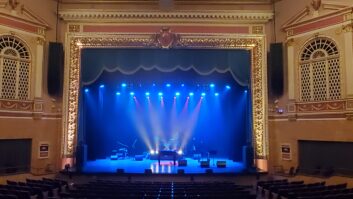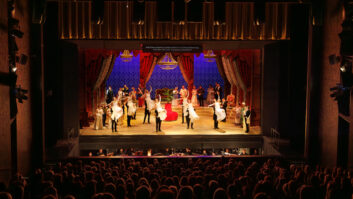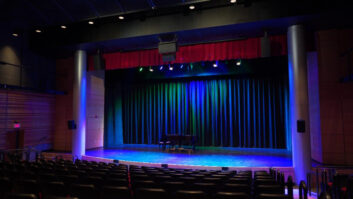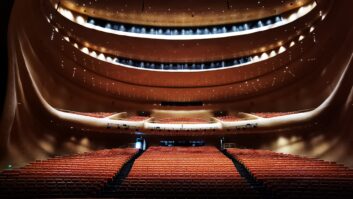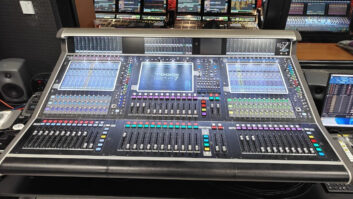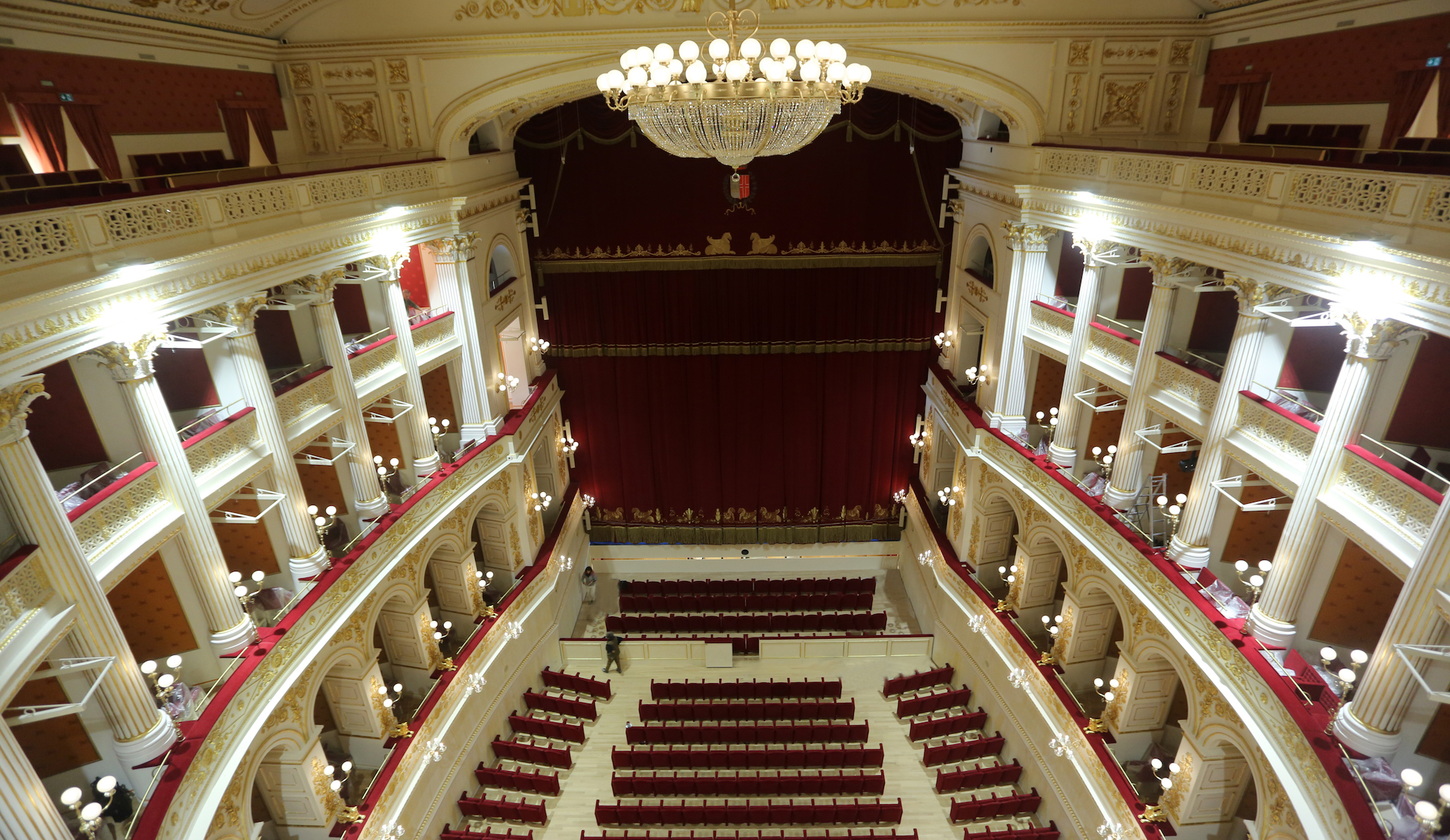
The municipal theatre of Rimini reopened on 28 October, following a complete rebuild and 75 years after hosting its last theatrical performance.
The original theatre (construction began in 1843) had a classic Italian opera theatre interior layout and striking Greek-Roman style exterior architecture. Originally called Teatro Nuovo, the venue seated over a thousand spectators and opened in 1857 with a performance of Verdi’s Aroldo. In 1947 the venue was named after composer Amintore Galli, but during World War II, the apse and roof collapsed, and most of the auditorium and stage were destroyed, leaving only the foyer almost undamaged.
Partial restoration was carried out between 1997 and 2001, and in 2010 the Municipality programmed a complete reconstruction of the theatre, which began in 2014. In 2015 the renovated foyer was reopened. The policy behind the reconstruction was to remain as faithful as possible to the venue’s original layout while respecting current safety regulations and installing the latest technology.
Inauguration events will be staged for two months, featuring international stars (such as Roberto Bolle & Friends), the annual Malatesta Music Sagra, prose and more. Today’s best-selling classical artist, with five Grammys to her credit, mezzo-soprano Cecilia Bartoli performed Cenerentola in semi-scenic form with her Musiciens du Prince ensemble on the first night.
Project development
The project was realised by Rimini’s Studio Ti and Daniele Naldi, head of AV and lighting at Bologna’s Municipal theatre, was consultant for the development of the audio and video project. The tenders for AV, lighting and stage equipment was won by system integrator Decima.
Decima’s Enzo Trovato explains: “As far as the client’s brief was concerned, utmost flexibility was fundamental, to meet a wide variety of requirements: opera and prose, concerts, presentations, conferences, meetings and debates, so the infrastructure plays a key role, with fibre and Ethernet connections throughout able to handle all kinds of stage lighting, video recording and streaming necessities, as well as audio and intercom requirements.”
The audio system had to ensure top-grade sound quality and even coverage in all seats, so Materiacustica Srl, a spin-off company of Ferrara University, used Odeon V14 software to create a 3D acoustic model of the theatre, which informed the decision on what loudspeakers were selected and positioning. The audio system design was by Guido Diamanti, also responsible for final tuning and EQ.
A Coda system has been installed, comprising two-way ultra-compact line source column systems, with a pair for each of the three tiers of boxes, the stalls and the gallery. These enclosures are used along with four extension enclosures for the low frequencies. To complete the setup there are four subwoofers, six front fill enclosures and four low-profile stage monitors. The system is powered by four 5,000W four-channel DSP amplifiers.
A Yamaha Rivage PM7 digital mixing system is positioned in the audio/video control room and a Yamaha QL5 is available for productions requiring a FOH desk (either in the centre box of tier 1, along with the lighting desks, or via floor-recessed connector panels in the stalls). The main control room hosts two of the four multi-channel desk stations of the venue’s large Green-GO digital intercom/paging system.
As well as the joystick control panel for cameras covering the stage, the AV control room setup includes video mixer and matrix, recording hardware, streaming facilities, multiviewer and monitors for image control and post production work.
Easy configuration
To create a show archive, a remote-controlled HD colour camera is installed at the height of the ceiling of the centre box on the first tier, enabling events to be covered from various angles. Connection points are ready for the installation of two more cameras in 3 boxes stage left and stage right. Although effectively mobile, a PTZ camera is normally set to cover the conductor. The cameras are integrated with the control system, ensuring easy configuration and control by a single operator. The modular mixer and matrix can be expanded according to future needs.
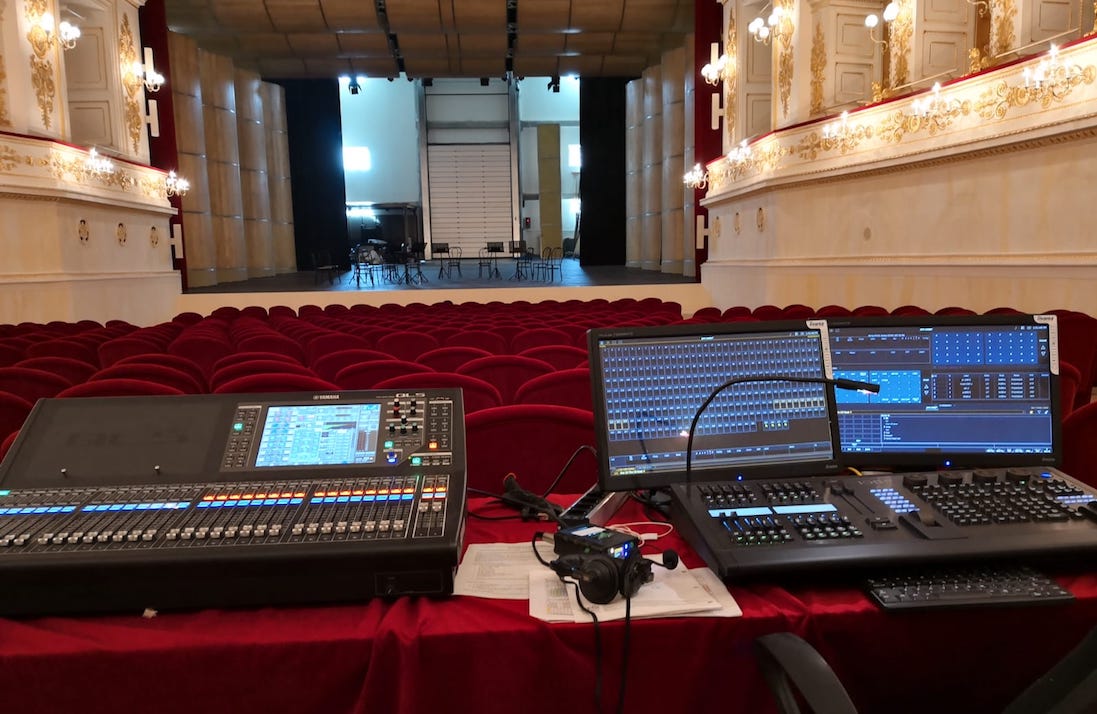
The initial stage lighting rig has 94 fixtures (PCs, Fresnels and Cycs). Bespoke track-mounted rigging is installed on the ceiling of 10 of the boxes, ready to be extended, equipped with additional FOH lighting, or retracted out of sight. The two ETC Sensor3 dimmer rooms are positioned in such a way as to keep cable runs as short as possible. One is dedicated to the stage lighting, orchestra pit, proscenium boxes, catwalks and grid with relative battens, the other to house lighting (the huge centre chandelier, box lights, etc.). It also controls service lighting in the stage zone and blue light for safe illumination during live productions.
The stage room hosts two racks with 144 3kW circuits and 38 5kW circuits. The other’s rack has 66 3kW circuits and four 5kW circuits. All are extractable ThruPower modules as well as two compact Ion Xe consoles. Control is also possible via a Unison Paradigm Mobile Button Station App, which enables the operator to recall lighting presets, combine spaces, control zones, and record, activate, and deactivate presets all from a smartphone or tablet.
“For house lighting, this is the first project on which we’ve used the ArcSystem range of modular LED lighting and control products by GDS, whose particularities include smooth accurate dimming down to absolute zero using wired DMX or ArcMesh wireless protocol, with a ‘Fade to Warm’ feature that mimics incandescent red shift by warming the light as it dims,” says Trovato. “The compact 4.8W ArcLamps chosen for the project are clear Candle models with 2700K colour temperature, replacing existing tungsten/incandescent lamps and offering 90% savings in energy consumption, another aspect worthy of note. Twelve ArcLamp drivers are deployed at the Galli, each able to drive 120 ArcLamps.”
To distribute signals to and from the patch panels in the dimmer rooms and in the video and audio rack rooms, SCB (Sound and Control Boxes) and PLB (Production Lighting Boxes) are widely deployed. On-stage, there are two PLB, six on the grid and others in the boxes, with a QR code on the face plate of some, used (via a specific app) to interface with the ETC ThruPower and regulate the dimmers or change channels from dimmed to switched without going to the dimmer room or lighting console. SCB boxes are equipped with XLR, opticalCON, speakON, BNC and etherCON connectors, according to needs and touring productions can hook up to three Company Switches (two 125A units and a 200A version) for their power supply.
For lighting power and control distribution, in the grid boxes Link LKS Data connectors feature (in place of the ground pins) micro coax contacts, enabling each cable to carry two DMX signals or digital audio pairs. Decima requested a flat version of Link’s Power Multilines & Data hybrid cable to facilitate use and reduce the number of cables deployed. As well as all the stage rigging (including hoists by Verlinde Stagemaker and the company’s own winches), Decima also supplied the grid, stage floor, a stage lift and two orchestra platforms, as well as the decorated house curtains with traveller, swag and fly opening.
Trovato concludes: “The Galli definitely stands out from many other theatre projects for the attention paid to developing a flexible multi-function project with the most innovative technology available on the market.”
www.adbstagelight.com
www.aja.com
www.codaaudio.com
www.courtyard.co.uk
www.etcconnect.com
www.gds.uk.com
www.rossvideo.com
www.yamahaproaudio.com
